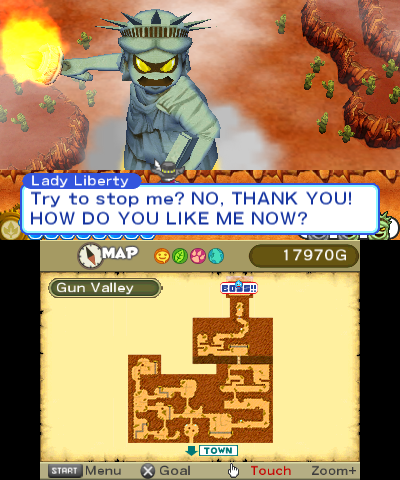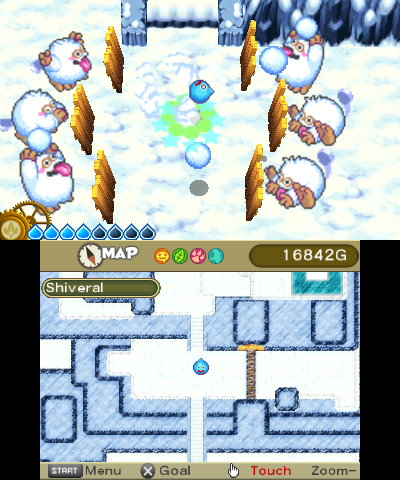- Genre: Action RPG
- Platform: 3DS
We’ve only been fortunate enough to get one of the entries in this Dragon Quest sub-series in the US. Luckily, an English patch has been created by a group called Fan Translators International, and it’s a quality one. I’ve been going through the process of backing up a lot of my older disc and cartridge games, and DS/3DS was up so I figured I’d take the opportunity to play through this one in English, and that was definitely the right choice.
The Rocket Slime games are kind of hard to describe, but the short version is that it switches between two main types of gameplay – an overworldish section where you collect items and monsters to build ammunition and crew and a battle-based segment where you engage in ship vs ship combat. The second one is definitely the thing that’s worth playing.
The overworld stuff is all well and good, but it basically exists to serve the purpose of grinding out ammunition for your ship. You use the same movement as ship battles in terms of flinging the player around and grabbing things, but there’s no real challenge here, even in the handful of boss battles. You go around, mop up everything, and send it off to your ship. Parts of it become pretty grindy as you get a bunch of parts to craft higher level stuff, but you get through it to make your ship stronger. If there’s anything to really point at as a major experience killer, it is that grind. Getting your ship together for the end game fight was really a hassle that I wasn’t expecting.
The ship battles just work so well. It’s a pretty basic loop, but has a really nice rhythm. You’re basically being given periodic dumps of ammo that you’ve collected throughout the world, picking it up, and chucking it into upper and lower shooting cannons. You’re doing this both offensively and defensively – hitting the enemies shots will knock them down, getting through to the enemy ship damages it. You can also fire yourself and your crew, allowing you to wreak havoc on the enemy ship, taking out their ammo feeds and really minimizing their ability to fight back. Once the enemy reaches 0 HP, you invade their ship and destroy their engine. That’s really all that there is mechanically.
That said, it works so damn well. On the ammo front, you get a feel for roughly how often you’ll get ammo and where on your ship it will show up, so you start picking out ship hulls that allow you to maximize your routing efficiency in picking up and chucking ammo. You start finding crew combos that work best with your play style. In particular, I had a combo where two crew split cannon duty and a third one chucked itself at the enemy ship to cause damage while I defended from enemies coming on board. It’s the kind of experience where even though a lot of the fights are generally the same, it doesn’t stop being fun.
The game we got as Rocket Slime on the DS was a really fun experience, featuring similar gameplay with tanks instead of pirate ships. Knowing that this game had been released in Japan and wasn’t being seen here – despite the popularity of the Dragon Quest main series – was a major bummer. I’d imported this one a while back, but kind of sat on it knowing that I was probably going to want to wait for a fan patch. Luckily some enterprising fan translators got that done, so I was able to play through it.
It’s tough for me to generally recommend importing JPN-only games, and in this case that still kind of stands. Playing this involved a number of things; importing the game in the first place, converting one of my 3DSs to custom firmware, going through the process of setting it up for custom game patches, getting this patch on there. It was a lot of stuff to play one game, but for me it was absolutely worth it. This is a hell of a fun game with a unique ship combat system that we could use more of, and I’m glad I stopped being lazy about getting this stood up to play.





